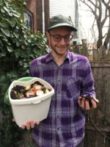American and European consumers are very familiar with PLA widely marketed as compostable for just about everything from chip-bags to golf-tees. This renowned PLA, a biological plastic made from a “left-hand” lactic-acid molecule, also has a quirk: it requires a pre-heat phase before it will actually biodegrade. That trait is referred to as Tg or “glassy transition” in the trade. Tg is a feature of all plastics and can occur over a very wide range of temperatures, but none as convenient as PLA’s at 55-58°C, making it eligible to be called compostable,- that is, if the compostability test is conducted at or just above the Tg temperature.
To be certified compostable means a standard is upheld such as ASTM 6400 for USA or EN 13432 for Europe. Coincidentally, these rules require compost test vessels to be held at 58°C during the entire test, referred to as industrial conditions. “This requirement effectively eliminates the Tg variable from being part of the test”, says Brinton. Brinton’s lab has experimented with clients in attempts to create blends of L-PLA possessing lower Tg for routine composting,- mostly unsuccessfully. “The temperature barrier of PLA is synthetic, not natural”, comments Brinton, “and now many people believe industrial composting is the only real composting”.
The Tg trait of bioplastic might go unnoticed were it not for the entrance of a cousin to PLA, right hand “D-PLA”. Tests conducted at Woods End labs on the right-hand enantiomer created by the Product Development Center at the University of Maine, show this same material which appears identical to PLA-L has none of the high temperature Tg limits. “This means it is compostable under any circumstance, just like leaves and hay and grass clippings.” says Brinton who has confirmed in trials that it decomposes rapidly even at room temperature. Therefore, the enforced distinction of “industrial” vs. “other” composting that is used to define the market for L-PLA, “well that distinction can eventually go away”, says Brinton.
Woods End admits there is a question if D-PLA has suitable properties for food packaging, and if not, what its best use would be as a consumer compostable product. Also, L-PLA is recylable and being a true bio-based plastic presents a good life-cycle profile especially if it can be made from non-food sources. Both products have a future. In any event, thinking outside artificial Tg limits should allow the industry to re-focus on composting as an inclusive and not exclusive trait in nature.
